ME lab III
0 likes66 views
The presentation is about ME lab 3 and its course syllabus and the course plan and the rubrics in gading ..
1 of 14
Download to read offline
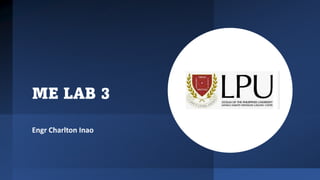

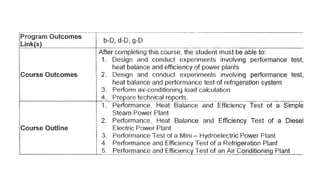
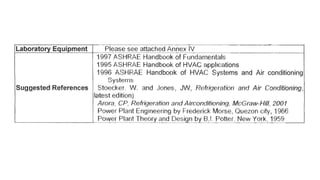



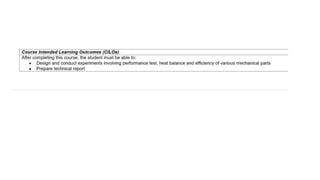
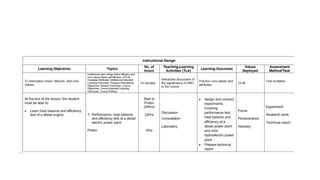
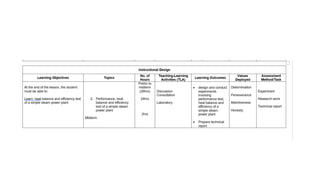
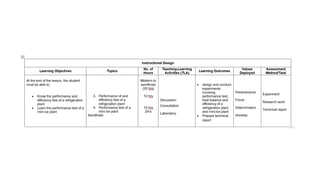

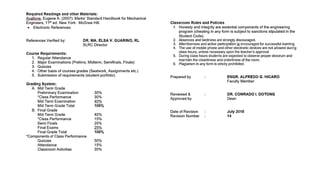

Recommended
happy wednesday.pptx



happy wednesday.pptxCharltonInao1
Ěý
This document appears to be about differential equations and refrigerants but the title is unclear as it contains random characters. It also mentions Brigada Eskwela and OCABIS but provides no other context or details to understand the purpose or key information within the document.PRINCIPLES OF AIR CONDITIONING.pptx



PRINCIPLES OF AIR CONDITIONING.pptxCharltonInao1
Ěý
This document explains how air conditioners work through a simple refrigeration process using key components like the compressor, condenser, and evaporator. The refrigerant is compressed into a hot gas and moves to the condenser to dissipate heat before becoming a cool liquid and entering the evaporator. As it evaporates, it extracts heat from the surrounding air and is blown into the home by ducts. This cycling process continues automatically via the thermostat to maintain the desired indoor temperature.Engineering Data Analysis-ProfCharlton



Engineering Data Analysis-ProfCharltonCharltonInao1
Ěý
__________
Total: 100
8 0.00 IIII IIII IIII IIII IIII IIII IIII IIII IIII IIII IIII IIII IIII IIII IIII IIII IIII IIII IIII IIII IIII IIII IIII IIII IIII IIII IIII IIII IIII IIII IIII IIII IIII IIII IIII IIII IIII IIII IIII IIII IIII IIII IIII IIII IIII IIII IIII IIII IIII IIII IIII IIII IIII IIII IIII IIII IIII IIII IIII IIII IIII IIII IIII IIII IIII IIII IIII IIII IIIIIndustrial and Manufacturing Processes



Industrial and Manufacturing ProcessesCharltonInao1
Ěý
This document outlines various manufacturing processes and related equipment across several industries. It covers topics such as plumbing, packaging, cement making, steel and glass production, plastics and rubber manufacturing, food and beverage production processes like soda making, beer brewing, sugar processing and rice milling, electronics and semi-conductors, metalworking techniques, industrial drying, and equipment for handling solids.REVIEW OF POWER PLANT



REVIEW OF POWER PLANTCharltonInao1
Ěý
The document provides information on several thermodynamic cycles used in power plants and engines, including:
1) The Carnot, Stirling, Ericsson, Brayton, Rankine, and Otto cycles. Equations for calculating efficiency are provided for some cycles.
2) Diagrams show the pressure-volume or temperature-entropy processes involved in each cycle. The Carnot cycle involves two isothermal and two adiabatic processes. The Stirling cycle has four processes: two isothermal and two isochoric.
3) The Rankine cycle closely describes the steam power cycle. It involves isobaric heating of liquid to steam, isentropic expansion in a turbine, isobarME Orientation fo r Evening Class ME 1101



ME Orientation fo r Evening Class ME 1101CharltonInao1
Ěý
This document outlines an orientation for an engineering course taught by Professor Charlton S. Inao. It includes sections on course outcomes and a course outline to provide students with essential information about what they will learn. The course will cover key engineering concepts and skills through a structured syllabus to help students achieve the intended learning goals.Thoughts of ProfCharlton



Thoughts of ProfCharltonCharltonInao1
Ěý
Prof Charlton's thought about family, achievement s, conflicts,
responsibility, resolvin conflicts, Lesbian, gay, LGBTAnswer key in Microhydro Powerplant EXam



Answer key in Microhydro Powerplant EXamCharltonInao1
Ěý
This document contains details of a final examination for a Micro-hydro Powerplant course, including 20 multiple choice questions. The exam covers topics like pump head calculations, efficiency, energy equations, flow rates, horsepower determination, and multi-stage pump calculations. It provides the student name, date, directions to submit answers, and identifies the department and college administering the exam.Answer key final exam statics



Answer key final exam staticsCharltonInao1
Ěý
The document discusses a structural analysis problem involving a method of sections approach to find the force in member BE of a frame. Based on the given forces of 13 kN compression at Fef and 13 kN tension at Fce, the force in member BE is found. A shear diagram is also shown for the frame.Pe 3032, control systems engineering syllabus original as of 2 21- 2017



Pe 3032, control systems engineering syllabus original as of 2 21- 2017CharltonInao1
Ěý
The document provides a course syllabus for a Control Systems Engineering course. The syllabus outlines instructor details, course information including credit hours and prerequisites, course description and objectives, methods of instruction including lectures, tutorials, assignments and projects. It also details learning outcomes, the course outline and schedule organized by topic and chapter, required textbooks, assessment details, laboratory activities, academic honesty policy, due dates, and classroom behavior expectations.Answer to Final Exam Micro hyudro powerplant



Answer to Final Exam Micro hyudro powerplantCharltonInao1
Ěý
This document provides information and instructions for a final examination for a micro-hydro powerplant course, including 20 multiple choice questions. The questions cover topics like pump performance calculations, fluid flow, head loss, efficiency, power requirements, and multi-stage pumps. Students are asked to choose the most appropriate answer and submit their solutions to an online portal by the examination deadline of December 10, 2020.Chapter 1 introduction to refrigeration engineering



Chapter 1 introduction to refrigeration engineeringCharltonInao1
Ěý
Refrigeration engineering refers to the design, installation, repair, and maintenance of refrigeration equipment used to store perishable goods at low, constant temperatures. There are several main types of refrigeration systems, including mechanical compression systems, which use electrically powered compressors to move refrigerant between high and low pressures; absorption systems, which rely on heat rather than compressors; and evaporative cooling systems, which use water evaporation to lower air temperatures. Refrigeration systems work by absorbing heat during phase changes of refrigerants to cool enclosed spaces and rejecting that heat elsewhere, helping to preserve foods longer.Control system concepts by using matlab



Control system concepts by using matlabCharltonInao1
Ěý
This document introduces control system concepts and how they can be analyzed using MATLAB. It discusses open and closed loop systems, Laplace transforms, state variable approaches, and MATLAB commands to analyze systems. Examples are provided on determining transfer functions, computing step and frequency responses, plotting root loci and Bode diagrams, and performing time and frequency domain analyses. Block diagrams can be reduced and overall transfer functions obtained through series and parallel combinations.Board exam on druyers



Board exam on druyersCharltonInao1
Ěý
This document contains problems from board exams on dryers. The first problem asks to calculate: (1) the required flow of heated air mixture to dry cassava flour, (2) the capacity of the forced draft fan on the dryer, (3) the heat required for heating the air mixture, and (4) the percentage of fresh air in the mixture. The second problem asks to calculate various properties of air before and after passing through an adiabatic drier. The third problem asks to calculate: (a) the required amount of air and (b) the fan capacity to handle the air for drying sand in a dryer.Seat work on Ice refrigeration Apples and Strawberries



Seat work on Ice refrigeration Apples and StrawberriesCharltonInao1
Ěý
The document is a sample problem calculating whether 100 kg of ice at -2°C would be enough to cool 500 kg of strawberries from 27°C to 5°C. It provides the specific heat capacities of ice, water, and strawberries. Using the energy balance equation and substituting the given values, it calculates that 121.899 kg of ice would be required, so the 100 kg provided would not be enough.Microprocessor



MicroprocessorCharltonInao1
Ěý
This presentation is about the design and function of a microprocessor, how to program and how to interface it with other electronics machines and devicesChapter 3a air conditioning process



Chapter 3a air conditioning processCharltonInao1
Ěý
This document discusses air conditioning processes and psychrometric charts. It defines key terms like humidification, dehumidification, and psychrometric properties. Humidification is the transfer of water vapor to air, using methods like wetted mats or spraying water droplets. Dehumidification reduces moisture in air. Psychrometric charts plot air properties like dry bulb temperature, wet bulb temperature, relative humidity, and humidity ratio to determine conditioning needs. Sensible heating and cooling change air temperature without moisture alteration, while humidifying and dehumidifying impact both temperature and moisture.Chapter 3a air conditioning process pdf



Chapter 3a air conditioning process pdfCharltonInao1
Ěý
air conditioning process
This course is designed to tackle the fundamentals of Heating, Ventilating, Air Conditioning, and Refrigeration as they relate to human comfort in residential and industrial design applications. The main focus of the course will be to examine the fundamental criteria involved in sizing and design of HVAC systems as well as to investigate the equipment used to satisfy the design criteria. The culmination part of the course is the design of air conditioning and ventilation of a commercial or residential building as a final project or case study.
Ch 7. 1 use of copper tube in refrigeration /HVAC



Ch 7. 1 use of copper tube in refrigeration /HVACCharltonInao1
Ěý
. Air conditioning systems
2. Properties of moist air
3. Moist air processes
4. Space air conditioning
5. Indoor air quality--comfort and health
6. Heat transfer from human body
7. Heat transfer in building envelopes
8. Infiltration heat load and weatherizing
9. Computation of the heating load
10. Heat gain by solar radiation
11. Computation of the cooling load
12. Energy requirements for HVAC systems; building energy audit
13. Fans--performance, selection, and installation
14. Air flow in ducts and fittings
15. Design of duct systems
16. Codes & standards for building energy systems
17. Annual energy consumption
21CS642 Module 2 Generics PPT.pptx VI SEM CSE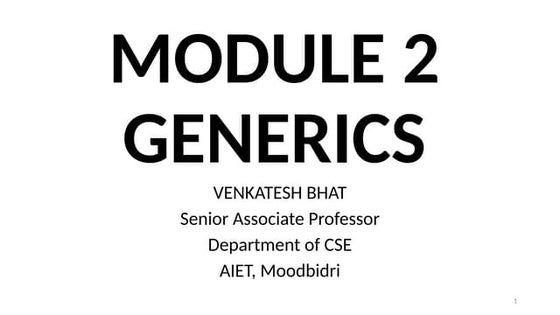



21CS642 Module 2 Generics PPT.pptx VI SEM CSEVENKATESHBHAT25
Ěý
21CS642 Module 2 Generics PPT.pptx VI SEM CSE 2021 Batch Students21CS642 Module 5 JDBC PPT.pptx VI SEM CSE Students



21CS642 Module 5 JDBC PPT.pptx VI SEM CSE StudentsVENKATESHBHAT25
Ěý
21CS642 Module 5 JDBC PPT.pptx VI SEM CSE StudentsCOMPUTER INSTITUTE Management system.pdf



COMPUTER INSTITUTE Management system.pdfKamal Acharya
Ěý
The product INSTITUTE MANAGEMENT SYSTEM offers records of students etc. in an
institute. To the users of this project are administrator, staff member. User is a person of
administrative staff at an institute. Therefore “COMPUTER INSTITUTE
MANAGEMENT SYSTEM” has been designed in such a way that it will automate the
manual work of administrative department by maintaining records such as fee records,
payroll records etc. The user can even manipulate the data such as by editing the records
to update them from time to time or can delete records which are no more required.Computer_Networking_A_Top-Down_Approach_6th_edition_ (2).pdf



Computer_Networking_A_Top-Down_Approach_6th_edition_ (2).pdfVENKATESHBHAT25
Ěý
Computer_Networking_A_Top-Down_Approach_6th_edition_ (2).pdfADVANCING PRIVACY AND SECURITY IN GENERATIVE AI-DRIVEN RAG ARCHITECTURES: A N...



ADVANCING PRIVACY AND SECURITY IN GENERATIVE AI-DRIVEN RAG ARCHITECTURES: A N...gerogepatton
Ěý
This paper presents an enhanced framework to strengthening privacy and security in Retrieval-Augmented
Generation (RAG)-based AI applications. With AI systems increasingly leveraging external knowledge
sources, they become vulnerable to data privacy risks, adversarial manipulations, and evolving regulatory
frameworks. This research introduces cutting-edge security techniques such as privacy-aware retrieval
mechanisms, decentralized access controls, and real-time model auditing to mitigate these challenges. We
propose an adaptive security framework that dynamically adjusts protections based on contextual risk
assessments while ensuring compliance with GDPR, HIPAA, and emerging AI regulations. Our results
suggest that combining privacy-preserving AI with governance automation significantly strengthens AI
security without performance trade-offs. Barriers to electrification of bus systems



Barriers to electrification of bus systemsms7218
Ěý
Barriers to electrification of bus systems: A fuzzy multi-criteria analysis in developed and developing countries
(Interested readers can find more information in the published open-access paper at https://doi.org/10.1016/j.enconman.2024.118700)
More Related Content
More from CharltonInao1 (13)
Thoughts of ProfCharlton



Thoughts of ProfCharltonCharltonInao1
Ěý
Prof Charlton's thought about family, achievement s, conflicts,
responsibility, resolvin conflicts, Lesbian, gay, LGBTAnswer key in Microhydro Powerplant EXam



Answer key in Microhydro Powerplant EXamCharltonInao1
Ěý
This document contains details of a final examination for a Micro-hydro Powerplant course, including 20 multiple choice questions. The exam covers topics like pump head calculations, efficiency, energy equations, flow rates, horsepower determination, and multi-stage pump calculations. It provides the student name, date, directions to submit answers, and identifies the department and college administering the exam.Answer key final exam statics



Answer key final exam staticsCharltonInao1
Ěý
The document discusses a structural analysis problem involving a method of sections approach to find the force in member BE of a frame. Based on the given forces of 13 kN compression at Fef and 13 kN tension at Fce, the force in member BE is found. A shear diagram is also shown for the frame.Pe 3032, control systems engineering syllabus original as of 2 21- 2017



Pe 3032, control systems engineering syllabus original as of 2 21- 2017CharltonInao1
Ěý
The document provides a course syllabus for a Control Systems Engineering course. The syllabus outlines instructor details, course information including credit hours and prerequisites, course description and objectives, methods of instruction including lectures, tutorials, assignments and projects. It also details learning outcomes, the course outline and schedule organized by topic and chapter, required textbooks, assessment details, laboratory activities, academic honesty policy, due dates, and classroom behavior expectations.Answer to Final Exam Micro hyudro powerplant



Answer to Final Exam Micro hyudro powerplantCharltonInao1
Ěý
This document provides information and instructions for a final examination for a micro-hydro powerplant course, including 20 multiple choice questions. The questions cover topics like pump performance calculations, fluid flow, head loss, efficiency, power requirements, and multi-stage pumps. Students are asked to choose the most appropriate answer and submit their solutions to an online portal by the examination deadline of December 10, 2020.Chapter 1 introduction to refrigeration engineering



Chapter 1 introduction to refrigeration engineeringCharltonInao1
Ěý
Refrigeration engineering refers to the design, installation, repair, and maintenance of refrigeration equipment used to store perishable goods at low, constant temperatures. There are several main types of refrigeration systems, including mechanical compression systems, which use electrically powered compressors to move refrigerant between high and low pressures; absorption systems, which rely on heat rather than compressors; and evaporative cooling systems, which use water evaporation to lower air temperatures. Refrigeration systems work by absorbing heat during phase changes of refrigerants to cool enclosed spaces and rejecting that heat elsewhere, helping to preserve foods longer.Control system concepts by using matlab



Control system concepts by using matlabCharltonInao1
Ěý
This document introduces control system concepts and how they can be analyzed using MATLAB. It discusses open and closed loop systems, Laplace transforms, state variable approaches, and MATLAB commands to analyze systems. Examples are provided on determining transfer functions, computing step and frequency responses, plotting root loci and Bode diagrams, and performing time and frequency domain analyses. Block diagrams can be reduced and overall transfer functions obtained through series and parallel combinations.Board exam on druyers



Board exam on druyersCharltonInao1
Ěý
This document contains problems from board exams on dryers. The first problem asks to calculate: (1) the required flow of heated air mixture to dry cassava flour, (2) the capacity of the forced draft fan on the dryer, (3) the heat required for heating the air mixture, and (4) the percentage of fresh air in the mixture. The second problem asks to calculate various properties of air before and after passing through an adiabatic drier. The third problem asks to calculate: (a) the required amount of air and (b) the fan capacity to handle the air for drying sand in a dryer.Seat work on Ice refrigeration Apples and Strawberries



Seat work on Ice refrigeration Apples and StrawberriesCharltonInao1
Ěý
The document is a sample problem calculating whether 100 kg of ice at -2°C would be enough to cool 500 kg of strawberries from 27°C to 5°C. It provides the specific heat capacities of ice, water, and strawberries. Using the energy balance equation and substituting the given values, it calculates that 121.899 kg of ice would be required, so the 100 kg provided would not be enough.Microprocessor



MicroprocessorCharltonInao1
Ěý
This presentation is about the design and function of a microprocessor, how to program and how to interface it with other electronics machines and devicesChapter 3a air conditioning process



Chapter 3a air conditioning processCharltonInao1
Ěý
This document discusses air conditioning processes and psychrometric charts. It defines key terms like humidification, dehumidification, and psychrometric properties. Humidification is the transfer of water vapor to air, using methods like wetted mats or spraying water droplets. Dehumidification reduces moisture in air. Psychrometric charts plot air properties like dry bulb temperature, wet bulb temperature, relative humidity, and humidity ratio to determine conditioning needs. Sensible heating and cooling change air temperature without moisture alteration, while humidifying and dehumidifying impact both temperature and moisture.Chapter 3a air conditioning process pdf



Chapter 3a air conditioning process pdfCharltonInao1
Ěý
air conditioning process
This course is designed to tackle the fundamentals of Heating, Ventilating, Air Conditioning, and Refrigeration as they relate to human comfort in residential and industrial design applications. The main focus of the course will be to examine the fundamental criteria involved in sizing and design of HVAC systems as well as to investigate the equipment used to satisfy the design criteria. The culmination part of the course is the design of air conditioning and ventilation of a commercial or residential building as a final project or case study.
Ch 7. 1 use of copper tube in refrigeration /HVAC



Ch 7. 1 use of copper tube in refrigeration /HVACCharltonInao1
Ěý
. Air conditioning systems
2. Properties of moist air
3. Moist air processes
4. Space air conditioning
5. Indoor air quality--comfort and health
6. Heat transfer from human body
7. Heat transfer in building envelopes
8. Infiltration heat load and weatherizing
9. Computation of the heating load
10. Heat gain by solar radiation
11. Computation of the cooling load
12. Energy requirements for HVAC systems; building energy audit
13. Fans--performance, selection, and installation
14. Air flow in ducts and fittings
15. Design of duct systems
16. Codes & standards for building energy systems
17. Annual energy consumption
Recently uploaded (20)
21CS642 Module 2 Generics PPT.pptx VI SEM CSE



21CS642 Module 2 Generics PPT.pptx VI SEM CSEVENKATESHBHAT25
Ěý
21CS642 Module 2 Generics PPT.pptx VI SEM CSE 2021 Batch Students21CS642 Module 5 JDBC PPT.pptx VI SEM CSE Students



21CS642 Module 5 JDBC PPT.pptx VI SEM CSE StudentsVENKATESHBHAT25
Ěý
21CS642 Module 5 JDBC PPT.pptx VI SEM CSE StudentsCOMPUTER INSTITUTE Management system.pdf



COMPUTER INSTITUTE Management system.pdfKamal Acharya
Ěý
The product INSTITUTE MANAGEMENT SYSTEM offers records of students etc. in an
institute. To the users of this project are administrator, staff member. User is a person of
administrative staff at an institute. Therefore “COMPUTER INSTITUTE
MANAGEMENT SYSTEM” has been designed in such a way that it will automate the
manual work of administrative department by maintaining records such as fee records,
payroll records etc. The user can even manipulate the data such as by editing the records
to update them from time to time or can delete records which are no more required.Computer_Networking_A_Top-Down_Approach_6th_edition_ (2).pdf



Computer_Networking_A_Top-Down_Approach_6th_edition_ (2).pdfVENKATESHBHAT25
Ěý
Computer_Networking_A_Top-Down_Approach_6th_edition_ (2).pdfADVANCING PRIVACY AND SECURITY IN GENERATIVE AI-DRIVEN RAG ARCHITECTURES: A N...



ADVANCING PRIVACY AND SECURITY IN GENERATIVE AI-DRIVEN RAG ARCHITECTURES: A N...gerogepatton
Ěý
This paper presents an enhanced framework to strengthening privacy and security in Retrieval-Augmented
Generation (RAG)-based AI applications. With AI systems increasingly leveraging external knowledge
sources, they become vulnerable to data privacy risks, adversarial manipulations, and evolving regulatory
frameworks. This research introduces cutting-edge security techniques such as privacy-aware retrieval
mechanisms, decentralized access controls, and real-time model auditing to mitigate these challenges. We
propose an adaptive security framework that dynamically adjusts protections based on contextual risk
assessments while ensuring compliance with GDPR, HIPAA, and emerging AI regulations. Our results
suggest that combining privacy-preserving AI with governance automation significantly strengthens AI
security without performance trade-offs. Barriers to electrification of bus systems



Barriers to electrification of bus systemsms7218
Ěý
Barriers to electrification of bus systems: A fuzzy multi-criteria analysis in developed and developing countries
(Interested readers can find more information in the published open-access paper at https://doi.org/10.1016/j.enconman.2024.118700)
Student Attendance Management System.pptx



Student Attendance Management System.pptxkamaljitbehera123
Ěý
Ppt about students attendance management system How to Write a Good Protocol (2025 IEEE Workshop)



How to Write a Good Protocol (2025 IEEE Workshop)Mathias Magdowski
Ěý
Workshop for the IEEE Student Branch Magdeburg
Not only for laboratory work, but also for research projects and in technical jobs in general, a correct and clear documentation of experiments and measurements in protocols is crucial. In this recording of a live-streamed workshop for the IEEE Student Branch of the OVGU Magdeburg, I have explained how to write a good protocol and how frequent mistakes of beginners can be avoided. Important rules and suitable software for writing protocols have also be shown. We also discussed some bad examples including suggestions for improvement as well as some LaTeX examples for plots and circuit schematics.Begin your journey to be a Selenium Committer - Valencia 2025 - Pallavi Sharm...



Begin your journey to be a Selenium Committer - Valencia 2025 - Pallavi Sharm...Pallavi Sharma
Ěý
The talk aims to help motivated individuals who would like to give back to Selenium, by contributing to the Selenium Documentation. CNS Nader F Mir.pdf VTU V SEM CNS Text Book 2018 Batch students



CNS Nader F Mir.pdf VTU V SEM CNS Text Book 2018 Batch studentsVENKATESHBHAT25
Ěý
CNS Nader F Mir.pdf VTU V SEM CNS Text Book 2018 Batch studentsVTU_BCS601 - CLOUD COMPUTING - SYLLABUS.pdf



VTU_BCS601 - CLOUD COMPUTING - SYLLABUS.pdfAslamNandyal1
Ěý
VTU, CLOUD COMPUTNG SYLLABUS, 6TH SEM, BCS601, Modules at a Glance:
Module 1: Distributed systems, network-based computing, and enabling technologies.
Module 2: Deep dive into virtualization—CPU, memory, I/O, and cluster-level automation.
Module 3: Learn the architectures behind cloud platforms like AWS, GAE, and Azure.
Module 4: Address top cloud security concerns and implement real-world defense strategies.
Module 5: Program cloud applications on leading platforms like AWS Lambda, GCP, and more.
Lab Experiments:
Create and deploy VMs
Use Cloud Functions for automation
Build and deploy web apps using App Engine
Implement CI/CD pipelines and Kubernetes clusters
Real-world challenge labs in Google Cloud and AWS21CS642 Module 4_2 JSP PPT.pptx VI SEM CSE



21CS642 Module 4_2 JSP PPT.pptx VI SEM CSEVENKATESHBHAT25
Ěý
21CS642 Module 4_2 JSP PPT.pptx VI SEM CSEME lab III
- 1. ME LAB 3 Engr Charlton Inao
- 2. Form CHED memo of 2017









